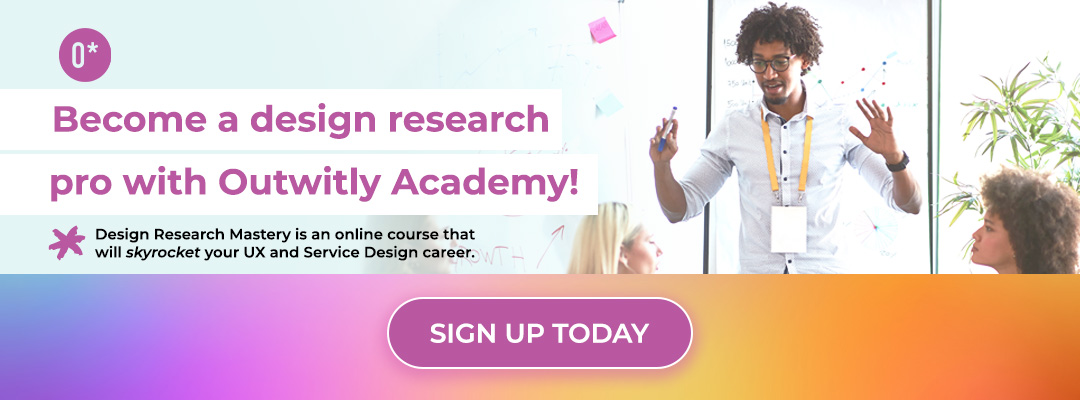In our new three-part blog series, we’ll introduce our favourite qualitative research methods and strategies that you can immediately start applying to your human-centered design projects.
We will cover the following three design research methods:
-
Contextual Observations (this post), and
What are observations?
Conducting observations with users is a key human-centered design methodology used to uncover unspoken needs and motivations. These observations, sometimes referred to as “contextual observations” or “shadowing,” are based upon methodologies developed in the field of Anthropology, in which you are observing people in their natural habitat or environment behaving as they normally would. Jane Goodall, famous anthropologist and researcher, pioneered observation methods in her work with chimpanzees. Prior to her research, no one knew very much about how chimps behaved. By patiently sitting for days and weeks to observe wild chimp behaviour and social interactions, Goodall made huge scientific strides in her field.
We take a lot of inspiration from early researchers like Goodall, whose methods can be applied across disciplines. Observations are a powerful research tool in design. In-depth interviews are of course very useful, but often, people aren’t very good at remembering or describing their own behaviours. They may falsely remember, exaggerate, or conversely under-represent certain challenges. By observing them as they use a product or service, you’re able to pick up on issues they may otherwise not have told you about. For this reason, data triangulation––combining observations with interviews and other forms of research like surveys or diary studies––is critical.
Observation Field Kit
Assuming you’ve already done the hard work of recruiting and scheduling participants for observations and setting-up site visits, you’ll next create an Observation Field Kit. A Field Kit is essentially a printed document that combines your customized observation guidelines, blank spaces for note-taking, and interview questions to ask on-site, into one handy booklet.
Here are the main components of a typical Field Kit:
-
Title page– Include fields to enter the Field Kit Owner’s Name, Date, Location, and/or Participant Number.
-
High-Level Agenda/Plan for the day (explained at more length below)
-
Introduction– This is a script that you read out to participants to remind them about who you are, why you are conducting the research, and what you are hoping to observe, as well as asking for permission or consent to take photos, videos, and audio recordings. (see Observation Etiquette below for more on this)
-
Task Checklist– This is a list of tasks and activities you hope to observe during your session. For example, if you are observing the use of a mobile app, you may want to list all of the features and tasks that you want to see/watch. Or if you are observing how a receptionist works in a doctor’s office, there may be particular tasks that you’d like to see–like patient check-ins and follow-up scheduling. Aim to observe 5–10 main tasks/activities per user type. These tasks can be very specific or broad catch-alls depending on how familiar you are with the users prior to arrival. Refer to this checklist throughout your observation day to make sure you are observing everything you’d planned.
-
Pre-Observation Interview Questions (optional) – If you have time built into the schedule to ask your subject a few questions before beginning the observation, include those questions here. Sometimes a pre-observation interview is helpful to set the context, and to learn a little more about your participant’s background and what their day typically looks like.
-
Observation Notes– This is the most critical component of the Field Kit, and you’ll want to include several blank pages for note-taking. Observation note pages should be mostly blank. Here is where you’ll take notes about what tasks the subject is doing, in what order the subject is doing them, issues you notice, and so on. Include spaces for Activity/Task Type, Time of Day, Duration of Task, Environment, Tools and Technology, Pain Points, Likes, and Questions.
In our Outwitly Field Kits, two thirds of each page is left blank for notes, and one third of the page has sections for the above-mentioned headings. The headings serve to remind you to jot down notes on these specific topics––sometimes in the moment, it can be hard to remember to take notes about these things because you are so focused on what the participant is doing.
In the past, we have also used observational research frameworks like the AEIOU framework (Activities, Environment, Interactions, Objects, and Users), or the POEMS framework (People, Objects, Environments, Messages, and Services). These tools can organize all of the data as you collect it, rather than afterwards.
-
Post-Observation Interview Questions (optional) – Similar to the pre-observation interview questions, it’s helpful to build some time into the observation schedule for a 15–30 minute debrief chat with the participant to ask specific questions that may have arisen throughout the day, or that you didn’t get a chance to ask prior.
Observation Checklist
You’ve prepared your Field Kit, and you’re ready and excited to begin observing! Before you head out the door, what do you need to bring with you? Here’s our short checklist. (Note: if there are two of you conducting observations, each researcher should have a set of the following items!)
-
Clipboard– Observations require furious amounts of hand-written notes as you shadow your subject. You could be sitting, standing, walking, and so on––and you’ll need a hard surface to write on. We love the Poppin clipboard from Staples, plus they come in fun colours!
-
Camera (with video and photo functions)– Always ask ahead about camera use. Some companies prefer you to bring external devices that do not connect to WiFi or the Cloud, for privacy reasons (which means you can’t use your smartphone!) When permitted, smartphone cameras are often the most convenient option. For a more traditional digital camera, we like this one from BestBuy.
-
Audio Recorder– We talked about using audio recorders or recording phone apps in our last Research Methods blog post. You’ll need to get your hands on one for contextual observations as well. Typically, observations involve ad-hoc interviews or pre-scheduled, one-on-one interviews that you’ll want to record.
-
Extra batteries, portable phone charger, and SD Memory Cards– Make sure to have extra memory, batteries, and chargers for all your gear. You’d be amazed at how fast your audio recorder, camera, or smartphone can die. Portable chargers for smartphones are especially important to ensure you aren’t missing any action, and you can charge your phone while shadowing your subject, without being glued to a wall outlet.
-
Consent Forms– Bring several printed copies of consent forms, when applicable. You may not be required to have written or signed consent from your subjects, as this is usually up to the client you are working for. But it’s better to have too many forms than too few.
-
Field Kits– Bring a printed Field Kit for each day and location of observation. This will help keep your notes organized per site visit.
-
Blank paper or notebook– Bring blank paper or an empty notebook for extra notes, in case you fill up your Field Kit!
-
Pens, including extras if you run out of ink.
Click through for a sample field kit…
Observation Etiquette
Contextual observations require you to intrude on your subject’s professional or personal life in order to conduct research and uncover the important insights. Therefore, it’s important to remember to be courteous, flexible, and appreciative with the people accommodating you.
Here are our tried-and-true techniques for maintaining a higher level of comfort with your research participants:
PRIOR TO THE OBSERVATION DAY:
-
Send a “What to Expect” 1-page document that outlines what participants can expect from a day of shadowing. Explain the goals of the research, who you are, who you are conducting the research for, and the types of tasks/things you would like to observe. Also explain that you’d like to take photos and/or recordings with their consent.
-
Send a high-level agenda for the day, including your arrival and departure times, your planned lunch time, and when you plan to be observing them. Explain that your schedule will naturally follow their schedule, and that despite this agenda, you are flexible and willing to accommodate their regular activities.
-
Confirm the exact day, address, and time of arrival with the participant(s) 1–2 days before the observation.
-
Provide your contact information and ask for theirs (in case you are running late or need to get in touch).
ON THE OBSERVATION DAY:
-
Arrive on-time/early: Leave extra time for getting to the site/location–you never know if you’ll get lost!
-
Introductions– Introduce yourself and the researchers with you. The point of contact on-site may want to give you a quick tour of the location (office, home, etc). Also, ask to be introduced to everyone you might be observing that day. For example, at a doctor’s office, you might observe a physician, nurse, and the front office staff–ask to be introduced early in the day.
-
Go over the schedule/plan for the day: Ask your subject about their schedule for the day and if the agenda you sent still works, or if there are other plans that you need to accommodate.
-
Permission & Consent– If signed consent forms are required, ask your subjects to sign the consent forms and/or ask for verbal consent to take photos/recordings. Mention that you will only take recordings of what they feel comfortable with.
-
Questions– Ask if they have any questions before the day begins.
5 Tips for Observers/Researchers
If you’ve followed all of the advice above, you are ready for successful observations!
Here are a few additional tips to keep in mind:
-
Be a fly on the wall: Your main goal during a day of observation is to understand the needs, pain points, and motivations of the user. In order to do that, it’s important to minimize the impact your presence may have on their typical behaviour. Of course, people sometimes naturally try to show you the best version of themselves on the day you are there to observe, because they know they are being “watched.” Try your best to silently observe them for most of the time you shadow. Participants usually feel comfortable pretty quickly, and it’s okay to remind them that you want to observe how they would usually behave if you weren’t there, and to ask them to go about their day as they normally would. Do your best not to interrupt as they complete tasks–instead, take notes, and when there is a quiet moment or down time, ask them clarifying questions about what you observed.
-
Document, document, document: Take as many hand-written notes as you possibly can in your Field Kit! Document everything you are observing, from the specific sequence of tasks the subject is doing (which can later be turned into journey maps and workflows), to notes about what the environment looks like, the tools and technology you see them using, and so forth. The AEIOU framework mentioned earlier should help you do this. In addition, take as many photos and videos as you can. This will help you recall certain details about the observations later on, and will help you communicate your findings to the project team who were not there with you. Also, whenever you have one-on-one interview time with the participant, be sure to record audio (again, all with permission!)
-
Embrace flexibility and ambiguity: Conducting observations can feel unnatural, and despite your agenda, you’re really at the mercy of your participants and what they have going on. Do your best to be flexible and go with the flow. If you end up staying longer, or taking a shorter lunch, or observing one type of task in the morning and switching in the afternoon––just go with it. You need to open your mind, learn as much as possible, and recall important details––so these days can be quite long and exhausting.
-
Don’t overextend/Stay within scope: Before you conduct your observations, it’s crucial to have a clear set of goals and tasks you’d like to observe prior to arrival. Establishing the scope of what and who you will observe during a day is key to ensuring you have enough time to observe everything you need. If you simply try to observe everything and everyone, you won’t garner enough details, which will make reporting insights very difficult, especially if you are trying to identify patterns across several days of observing many different users.
-
Finish strong: At the end of an observation day, or as soon as possible afterwards, do three things: 1) Debrief with the other researchers who were present during the observations and highlight major similarities and differences you each observed, as well as the questions you still need answers for; 2) Type up your notes ASAP– it’s so easy to forget all the details if you are typing up your notes a week later; 3) Upload and organize recordings, photos, and videos to a storage folder. If you conduct a week or two of observations, it can be easy to forget which photos were taken when, and who is in each audio recording–so do this at the end of each day!
In the third segment of our Design Research Methods blog series, we delve into the practical uses and applications of Diary Studies in design.






